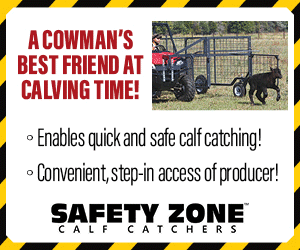Reducing the trauma of this 45-day event will pay off down the road
By Gilda V. Bryant
Now that the spring calf crop is on the ground, it is time to develop a comprehensive marketing plan. Consider how to prepare calves to better survive the rigors of weaning, as well as vaccinations, branding, castration and the trip to a feedyard. Make sure that plan includes whether or not to take animals to the sale barn, feedyard or retaining ownership of calves in the feedyard.
Chris Hitch, fifth-generation rancher, is President and CEO of Hitch Enterprises located smack-dab in the middle of the Oklahoma Panhandle near Guymon. Founded in 1884, this family-owned business includes raising stockers and running two feedyards with a total capacity of 95,000 animals. The Hitch Ranch runs some 5,000 head of Angus-influenced steers and heifers at any given time on 15,000 acres of native and improved pastures.
Hitch says that weaning conducted the old-fashioned way–the abrupt separation of cows from their calves, is too traumatic. He prefers the less stressful fenceline weaning method. He likes to wean calves that are five to six months old, weighing 500 to 550 pounds, and if grass becomes dormant before weaning, he recommends early weaning. By separating calves with a secure fence from their mamas, cows can comfort their calves, but calves cannot nurse.
“Being able to smell one another and having mama right there eases the weaning process,” Hitch explains. “Over the course of a week or so, everything is settled and everybody is okay. I consider weaning to be a 45-day process regardless of the weaning style. Calves will go through the traumatic effects of weaning, stress and sickness that occur, [then return] to health, ready to grow at the end of the process.”
Consider breaking stressful events into steps so the calf is not overwhelmed. Less stress equals more likely positive outcomes. For instance, instead of branding, deworming or vaccinating during weaning, Hitch encourages producers to take care of these chores about two months before the big day. Spring calves are around three to four months old and still small enough to manage easily. Larger calves can be worked in the chute. As a separate step, he chooses to band older calves instead of surgical castration.
Now, the mineral part
Consistent mineral supplementation helps calves stay healthy and robust according to Nathan Elam, Ph.D., Consulting Nutritionist with Nutrition Services Associates in Hereford, Texas. He works with both the Hitch Ranch herd and Hitch Feedyard animals. At the ranch level, calves receive minerals in a complete feed program. If the complete feed lacks minerals, a trace mineral salt is available to them as either a block or loose mineral. Elam says the salt stimulates intake, yet encourages the correct amount of consumption. Minerals are critical for calves to fight stress and stay healthy as they grow. Hitch Feedyard animals receive a fortified mineral package with balanced vitamins and minerals in the rations, especially the starting ration.
“Micronutrients are utilized by the biological systems in the body to both elicit an immune response, and fight disease at the cellular level,” Elam explains. “Several of those micro-nutrients are key players [such as copper, zinc and selenium]. Some minerals are stored in the body; some are not. We want them to be available for the body to use as necessary.”
Elam says it is always a good idea to maintain a high-quality mineral program throughout the year, because it is beneficial for maintenance as well as various life stages, such as pregnancy, gestation or lactation. “I think that if we have cattle in a high plane of nutrition, the body is not deficient in [the nutrients] it needs to elicit an immune response to fight off disease,” Elam reports.
Producers can employ management strategies to make their animals attractive to a buyer, and successful in the feedyard. For instance, feed calves protein pellets from a bunk several times a day. Drive tractors and pickups around them. Let them become accustomed to people, machinery and other animals, so that it is less stressful for them when they arrive at the feedyard.
If producers plan to truck animals to a feedyard on a long haul of 15 to 16 hours, preparing them for shipping is critical. “You want animals to have the best chance for success,” Hitch says. “[Bring them in], let them rest overnight, filling their bellies full of straw or grass hay that isn’t going to digest very fast. Give them fresh water and ship them early the next morning.”
Feeder wants to see records
On the feedyard side, Hitch likes to see a vaccination history with injection dates for each animal. Include information about the gains calves made if they were in a stocker operation. List the dates of all injuries and illnesses, castration and dehorning or the disbudding of horns. Wean calves a minimum of 45 days before arriving at the feedyard or joining a stocker operation. Large groups of cattle should be sold in lots of like size, sex and age.
Has the calf been comingled with animals from other ranches? If so, when did it happen? Hitch says the sale barn does not count. Naive cattle that come from the ranch to the feedyard can suffer some disease exposure at the feedyard because they do not have adequate immunity. That is when vaccinations become especially important. On the other hand, ranch calves that have been comingled will have decreased morbidity and mortality in the feedyard.
At the same time, Hitch buys cattle straight from the ranch. “We make sure those animals have been vaccinated and weaned properly before we get them,” Hitch reports. “That’s how we offset that naivety.”
Disposition is a big deal in the feedyard. Temperament goes back to cattle herds, sires, dams and the breed. It also depends on how producers have treated their cattle. If they have been worked calmly, slowly and quietly without using electric cattle prods, cattle tend to be relaxed, and will eat well, gaining weight with fewer illnesses and injuries. Docile cattle are significantly easier to handle and are much safer for ranch and feedyard employees, as well as other animals.
Retained ownership
According to Hitch, it is easy to explain retained ownership in a feedyard, but it is complicated to do. This is where a detailed action plan made in advance is vital for success. Think about risk management and do not cut corners. For example, producers should determine which feedlot and trucking company are best for their cattle. Maybe the sale barn is the wise choice. The plan should include possible retained ownership in a feedyard.
“Include a vet if you’ve never done anything like this,” Hitch advises. “He will give you a good combination of vaccinations to keep your animals healthy in the feedlot. If he doesn’t have experience with that, call a feedyard. Those folks will tell you what they’re going to give them and what they want the animal to have before arrival.”
A producer can also obtain information from state livestock associations, such as the Texas Cattle Feeders Association (TCFA) or the Kansas Livestock Association. Most states have land grant universities with extension service experts eager to help producers.
“Staff, facilities, location, time of year, and age of cattle will play a factor in any decision a rancher makes,” Hitch says. “If the rancher hasn’t done this before, he should call an expert to help with their decisions. Making a bad decision, no matter how well prepared, will end poorly.”
Many feedyard managers are paying a premium for cattle that have been vaccinated, castrated, dehorned, successfully weaned and are able to eat from a bunk. Arriving at the feedyard, calves are healthy, and more able to gain weight to reach their potential for a higher carcass grade and yield. And that puts money in a producer’s pocket.





